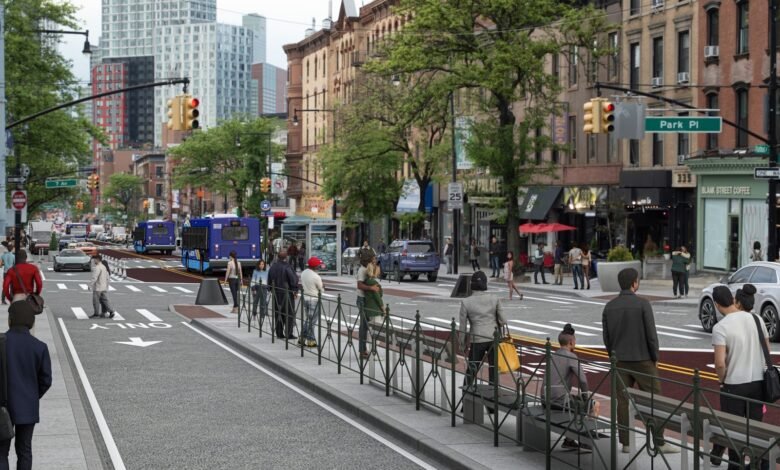Flatbush Avenue redesign to begin this fall


A rendering of NYC DOT’s Flatbush Avenue bus lane proposal at Flatbush Avenue and Park Place. Credit: NYC DOT
Flatbush Avenue is getting faster (and safer). Department of Transportation Commissioner Ydanis Rodriguez on Friday announced work will begin this fall on center-running bus lanes along the busy Brooklyn corridor, from Livingston Street to Grand Army Plaza. The overhaul aims to speed up trips for 132,000 daily riders, where buses now average less than 4 miles per hour. Slated for completion in 2026, the project also includes pedestrian islands with covered seating, shorter crossing times, and updated curb regulations to support local businesses.

“We are excited to get Flatbush Avenue moving. Today, 132,000 daily bus riders are stuck waiting too long for slow buses, drivers are caught in a mess of traffic, and pedestrians are left crossing intersections clogged with vehicles,” Rodriguez said. “These new bus lanes will speed up bus service and make the street safer for everyone.”
The agency expects to start installing bus lane markings and painted curb extensions this fall, resume work in spring 2026, and finish the project by that fall.
Flatbush Avenue is designated as a Vision Zero Priority Corridor and is one of Brooklyn’s most dangerous streets, with 140 people killed or severely injured during the past five years.
According to MTA estimates, annual ridership on the B41 bus—which runs nearly the entire eight-mile length of Flatbush Avenue—is over 4.4 million riders, ranking it among the 10 busiest bus routes in the city. The high ridership reflects the fact that nearly 60 percent of households along the corridor lack personal vehicles.
Buses along the corridor primarily serve Black, female, and low-income riders. Most live in surrounding zip codes and have household incomes below $80,000, according to a Pratt Center study. Many of these riders report long waits in extreme weather, and one in three say slow service has caused them to be reprimanded at work, lose pay, or even fired, as 6sqft previously reported.

Plans to revamp Flatbush Avenue have been in the works since 2022. In June, the DOT released its latest proposal, calling for center-running bus lanes on the avenue’s northern stretch, from Livingston Street to Grand Army Plaza, where service is slowest.
Specifically, the project will add six large concrete bus boarding islands totaling more than 13,000 square feet, creating physically separated lanes and an improved transit experience. The plan also includes 14,300 square feet of new painted pedestrian space, further enhancing the streetscape.
According to the agency, the boarding islands would create a “train-like service experience” for bus riders and also reduce instances of speeding drivers.
The DOT says center-running lanes are the best option for improving bus speeds, as they separate buses from personal vehicles. A similar redesign on the Edward L. Grant Highway in the Bronx resulted in a 29 percent decline in pedestrian and cyclist injuries and a 17 percent drop in total injuries.
The plan also creates 11 new loading zones with capacity for more than 50 trucks or 83 passenger vehicles, along with 14 roadway bike parking areas for over 170 bikes.
Drawing on traffic analysis and past projects, the DOT expects the redesign to reduce traffic volume on Flatbush Avenue while creating a more welcoming experience for pedestrians, drivers, and bus riders.
RELATED:
Get Insider Updates with Our Newsletter!
Source link




